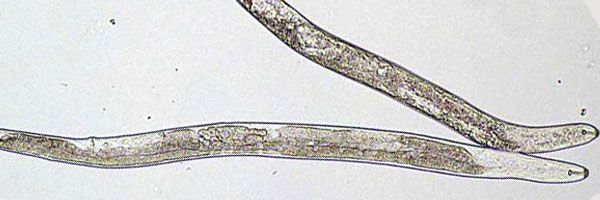
Ditylenchus spp. and other migratory nematodes
(genus Trichodorus, Pratylenchus,...)
(Stem and bulb nematodes & Potato rot nematodes)
- Causal agents and transmission
Potatoes like other plants can be infected by numerous motile nematodes which can have an ectoparasitic phase in the soil but are largely migratory endoparasites. These vermiform nematodes feed inside the plant (root or tuber) tissue and are able to circulate in the plant at almost any stage in their development except when in egg form. They do not form cysts or galls and hence are invisible to the naked eye.
Two species, Ditylenchus dipsaci and D. destructor, can be very damaging to the potato, as is suggested by their respective names, Stem-and-bulb nematodes and Potato rot nematodes. These are highly polyphagous species and develop on numerous crops and weeds, monocotyledons or dicotyledons and even on soil-borne fungi in the case of D. destructor.
The nematode spends the winter in the soil and in plant debris in the form of juveniles and eggs which easily tolerate frost, but die at a temperature below -5°C.
Infested tubers and the accompanying soil can be the source of new infestation as can be the underground parts of other infested host plants (bulbs, rhizomes).
- Signifiance
Ditylenchus destructor can be a serious pest. It is listed as a quarantine parasite in the European plant health legislation and is thus subject to mandatory control measures on seed potato tubers. It is present in rare places in most temperate countries; further dispersal should be prevented.
D. dipsaci, present in most temperate countries, is less harmful to potatoes than to other hosts such as peas, beans or bulbs.
- Other migratory nematodes
Among other migratory endoparasitic nematodes, the lesion nematodes (Pratylenchus spp., photo 1) may cause damage to potato tubers or to the root system with characteristic necroses.
In the case of severe infestation, there may be limited yield losses but the susceptibility of the plants to Verticillium wilt and other root pathogens like Rhizoctonia solani and Pythium spp. might be increased.
The free living nematodes, Trichodorus and Paratrichodorus spp., are migratory root ectoparasites also named stubby-root nematodes. When present in large populations, they may damage the potato, either directly by feeding on the root system thus causing necroses or indirectly by transmission of the Tobacco rattle virus (TRV).
In the presence of viruliferous nematode populations, susceptible cultivars to TRV may show spraing symptoms at harvest. Breeding for cultivars less susceptible to the spraing symptoms is an alternative to chemical control.





